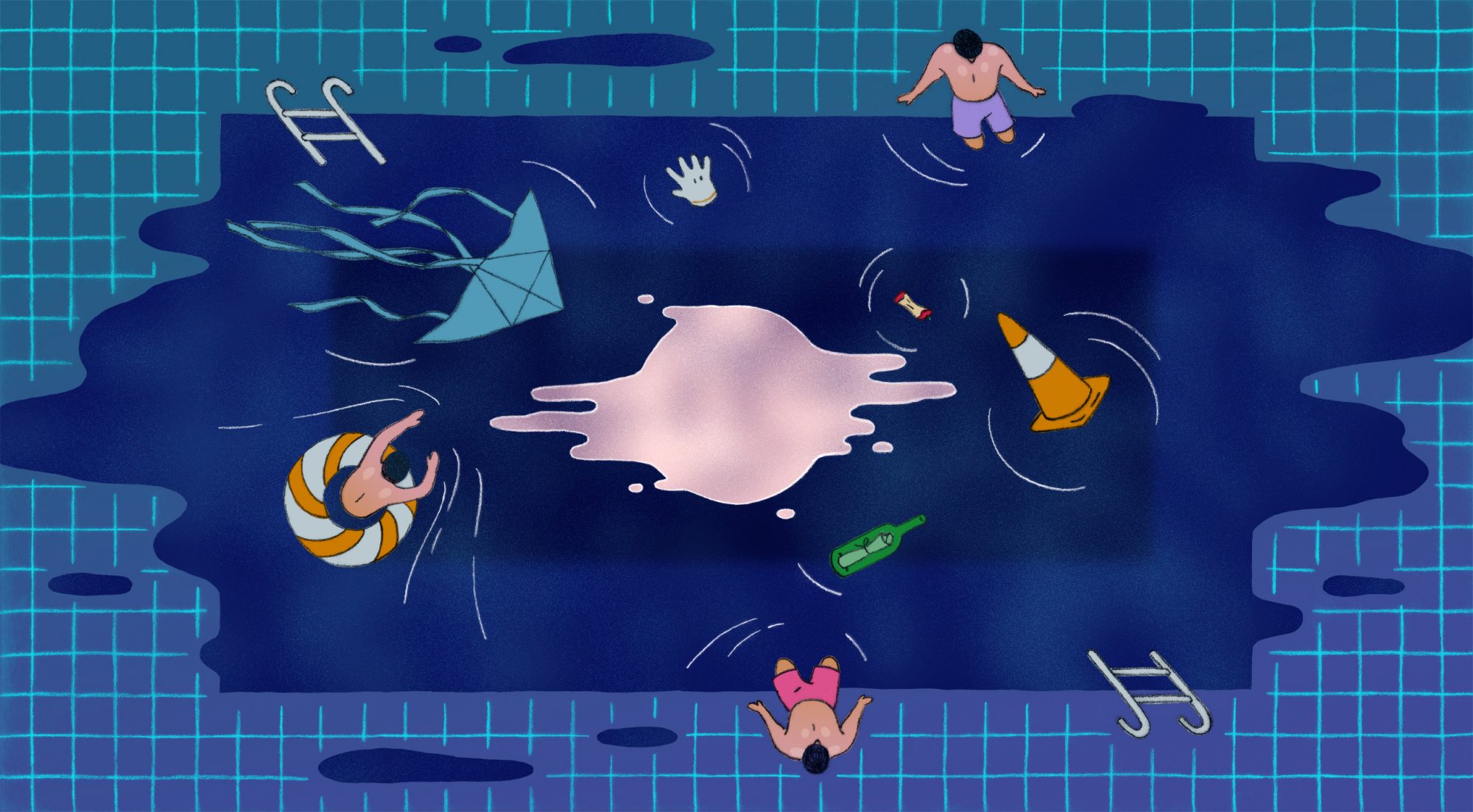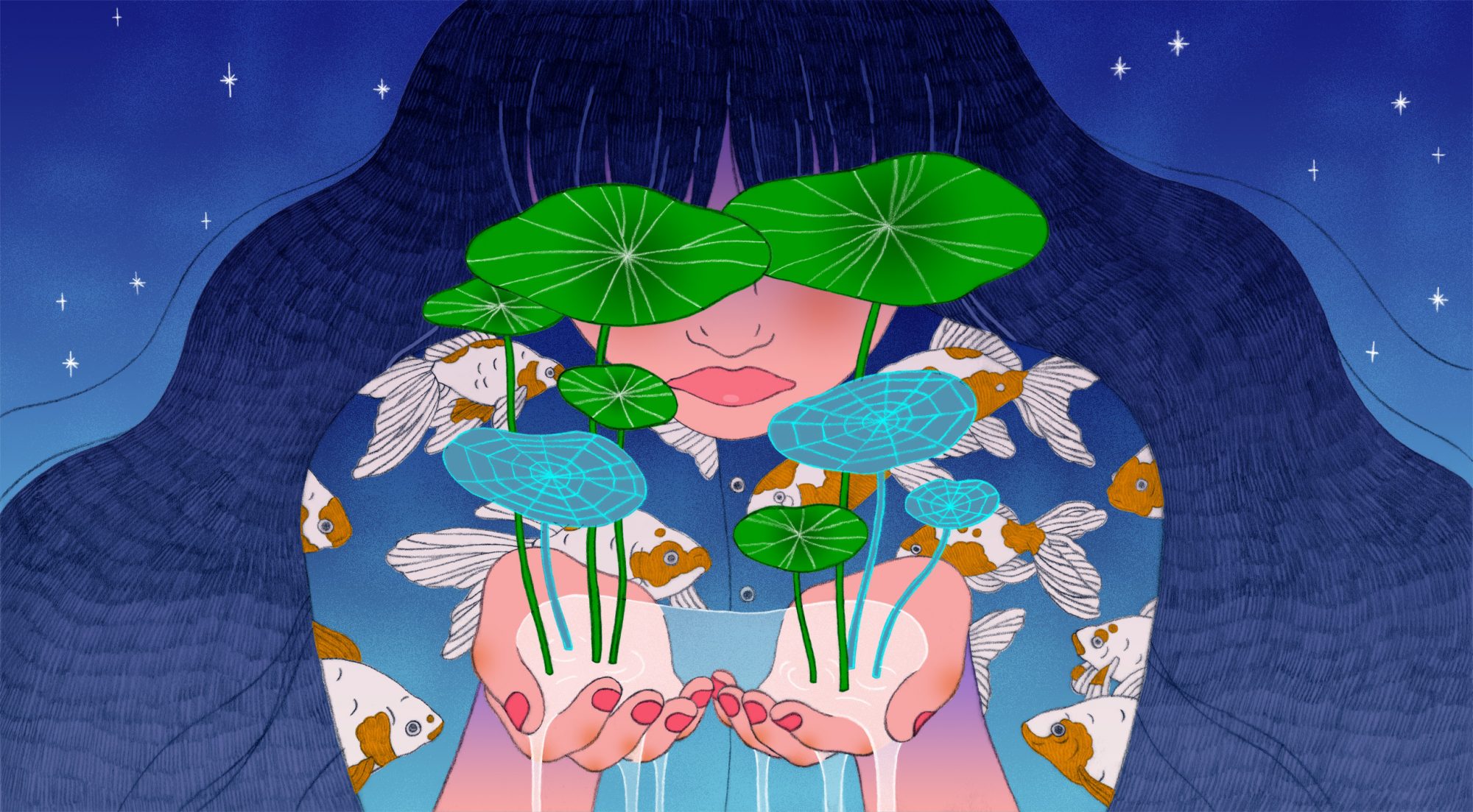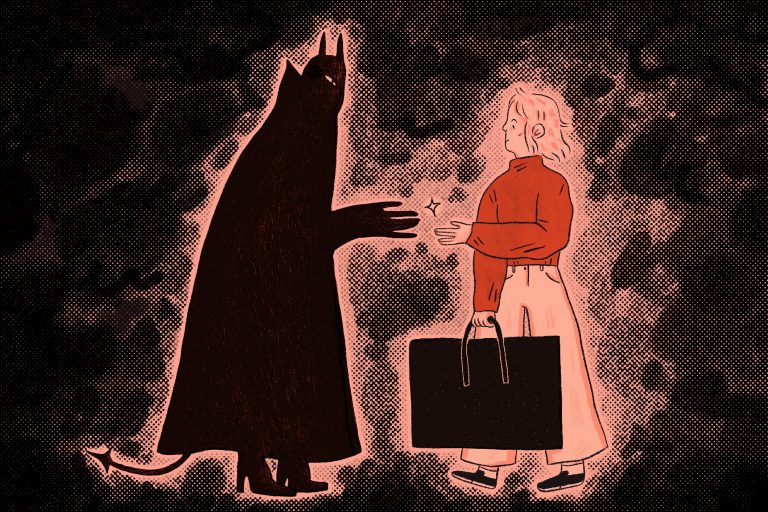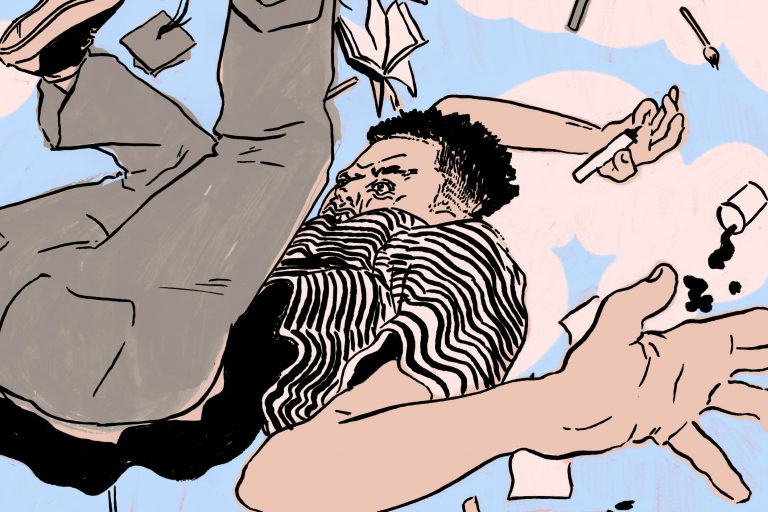
The School of Being
‘The School of Being’ is a vivid picture of what a future art school could — and perhaps should — look like. Come and dive right in
Words by Alternative Art School
Illustration by Jo Yeh
It is the year 2105. The exponential rise of voice assistance and 3D printing, Siri and the latter’s patent expiration anchored at its distant dawn, have paved the way for ‘revolutionary’ voice-to-being technology. Users speak aloud to the highly intelligent AI Voix, in a conversation between human thought and computed form. The result: generative realities, instantaneous building blocks, and a direct, uninhibited line of creation from thought to being. In its early stages of output, creatives read literature aloud to generate two-dimensional artwork. Relic libraries wore the shoes of art supply shops, and reading groups were revived as places of creative production. Cult classics like Orwell’s 1984 found resurgence as inventories for visual fuel. Now, much more advanced, the ability to speak something into being has reached the third dimension. Voix converts sound waves into trigonometric algorithms that, when processed through state-of-the-art haptic holographic rendering, can manifest in our visual reality. Speed has improved tenfold over the last decade too: a simple one-liner through to a complex narrative is mapped, accelerated, and then modelled in close to real-time.
Art schools in 2105 teach the emancipation of voice as a tool to create and an armour for visual dissent. We join the open day of one in particular, the School of Being. Here, participants create work solely through their dictation of thought. Elements of composition have grown beyond variables of colour, contrast or proportion. A participant’s voice is now their algorithm: intonation, stress, rhythm, and pause all become tools of the palette. A stutter can add patterns of repetition, stressed syllables to help elongate length, while volume may extrude or contract a being’s depth. Multilingualism favours one’s range, where a participant’s ability to reference, extract, unite and juxtapose secondary language immediately creates nuance. Lost scripts can be revived into new environments, and self-study of etymology is highly encouraged. Understanding the journey your utterances have taken plays directly into Being’s oeuvre. Pathways within the school offer participants ample room for creation. Some included are Talk Is Cheap, a train of thought into the language of promise, and Poetic Architecture, a weekly dialogue around stanza-manifested urban planning. We’ve been told by our guide the most popular amongst participants is Sounds of Nature, an introduction to pGW environments (pre-Global Warming), where lost ecosystems can be art-worked in 22nd century realities.
Participants in today’s Nature class have been tasked with manifesting the world’s rarest flower Youtan Poluo (now extinct), said only to have bloomed every 3000 years. One user is speaking their piece into being through narrative-led description, or a ‘scene-up’ as the method is known amongst peers. “It is the year 2057. Forty-three Youtan Poluo flowers are nestled tightly on a weathered roof tile”, they say aloud in the weekly group chat. “Its yellowed crevices are lined with faint raindrops. The flower is now only days from blooming.” Another student then chooses to ‘jabberwock’ (v2b slang for randomly spoken delivery): “Youtan Polou, extinctual flow / Flower bloom, pale white green / Buddhist myth, 3000 flower buds / 20 by 30, portrait red wash”. A moment later, Voix is at work and breathes life (and code) into their words. The other students gaze ahead as fragments of colour, line and texture iterate back and forth. Another moment later and their work is manifest.
Looking around, everyone in Being’s community appears to be of the same value to each other—equals in conversation. The professor-student hierarchy, a 21st century archaism, is fully obsolete here. As a way to avoid feedback based on personal taste or blinkered experience, work is streamed to RPAs (random public audiences). Voix is known to exhibit occasional glitching, and the RPA help to optimise visual trend patterning and improve its calculations. As we watch a session take place, it looks to remove any trends X is known to create; no longer visual showmanship, but a mediation between human and AI.

The participants speak aloud to reimagine the structures of Being, a hyper-dimensional version of Voix able to render itself through material form. Instead of the architecture shaping the actions of its inhabitants, this physical space is dictated by their actions themselves. The building mutates around the sound created inside, the same way a work of Voix would metamorphose. An endlessly flexible space allows for decisions to be made with inexperience, as there are no antagonists or repercussions. Participants hold regular discussions with the building about their needs, and it is always happy to oblige. Transparency of process and outcome are key to Being’s ethos, something intently built into its architecture. Aside of us, a sheet of glass hovers. Small, cell-like mutations are dancing across its surface; some still, some growing. The tour was due to continue when two cells collided and began to emit light. The guide pressed on the glow to reveal its voice: this was the Map of Being, and two participants had decided to collaborate. Their conversation and subsequent artwork were instantly visible in front of us. When more than one participant is speaking to Voix, the algorithm harmonises to the sound of new voice. Whether that emerges as debate, dialogue, or discourse, is entirely down to those involved. This system is available to all here, presenting itself transparently: an intuitive platform for participants to offer their knowledge, skills, and engage in new work. The Map visualises its participants with fluidity and delineates the school as an omnipresent network of thought.
The School of Being works to transcend its participants’ individual consciousness and connect to a shared unconscious through which they can create, independent of individual and external prejudice. They have no collective goal, relinquishing attachment to the concept of success, progress or growth in relation to their shared practice. In this case, egoistical output is suppressed in favour of responsive, mutative workflow. Voix is seen as a tool to embrace, but process is valued as much as its being. Skills of conversation dismantled at the hands of the 21st century remain a fervent cause of Being. The work of participants does not evolve to meet the needs of the environment but instead create new climates that provide context for their own evolution. It is possible at the School of Being to visualise the future, not as linear but, as infinite and communal, experiencing it and processing it collectively. In the 22nd century, the human organ of sound has surreptitiously emerged as a potent visual output for all to embrace.
_____
We’re four members of the Alternative Art School, an ongoing project initiated by Kingston School of Art lecturer Dr Cathy Gale and adopted by a group of BA Graphic Design students within their second year. The project offered us space within the institutional programme to unpack and toy with issues of art education and design practice through a series of symposiums and pedagogic experiments. In Gale’s words, the AAS “seeks to challenge and disrupt assumptions in the academic status quo. By increasing student autonomy and agency the AAS encourages its participants to manipulate and/or subvert the opportunities of art school, and to envisage alternatives.” The project had us create a Wall of Words, hold a club night called inter—course, and offer Foodback to our peers (and more here). All of these mini-projects came out of a need to rile up some furore around our education and make an attempt to reclaim it from the stale hands of neoliberalism. A speculative approach within the AAS then offered us further room to imagine scenarios — some closer to home, others more distant — whilst alleviating the difficulties of a future reality. This methodology helped to generate critical discussion around our learning and kickstart projects in other areas of the BA course. Crucially however, our imagined realities are not without issue, and it’s important we address those moments within Being.
The technology practised in this school harnesses voice, and voice alone; those impaired by hearing and speech are excluded by default. ‘Being’ in theory should encompass all sensory input and output; its practice fails entire demographics here. In any future tied up with AI and something borne by algorithm, the neutrality of its systems must be called into question. If voice or text become the input, how skewed by race, gender, or era, is its output? What histories have been included, and what histories have not? The fictional-for-now Voix may have subjected its users to an endless stream of terms and conditions containing that grey area, the kind that implicates every utterance it records (hey Alexa! 嘿Siri!). Free speech may no longer exist in 2105, and who knows what level of censorship a technology that advanced will dictate. How would this school, or any school in the future, attempt to address issues of class relations? Who has access worldwide to the School of Being? It’s important for us that these worlds we imagine offer alternatives to tomorrow’s future, but are able to ask questions of ourselves and confront the realities of today with urgency and tact.
A Parede, Modes of Criticism, and Scratching the Surface all put forth entries into the criticisms, speculation and discussion we have formed an interest in through this, and hope to encourage more of them within art school. Although the truth may be stranger than fiction, remember that what Margaret Atwood once wrote: “a word after a word after a word is power.”.

The School of Being is part of our new independent editorial series ‘The Crit’ which assesses the state of creative education from a variety of perspectives. The intention of the series is to instigate conversations that can open up clearer lines of communication between students, educators, institutions, graduates and industry. We want to improve transparency, empathy and dialogue between the key stakeholders because we believe wholeheartedly in the value of creativity and want to support those who teach and learn it alike. This feature is written by the brilliant Alternative Art School team comprising of Ollie George, Emma Teasdale, Sheona Turnbull and Joe Moreno. Their vision for the future has been elegantly crafted into striking visuals by our latest illustrator crush, Jo Yeh, who you need to follow on Insta, right here, particularly if you’re an art director.









